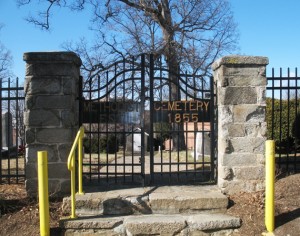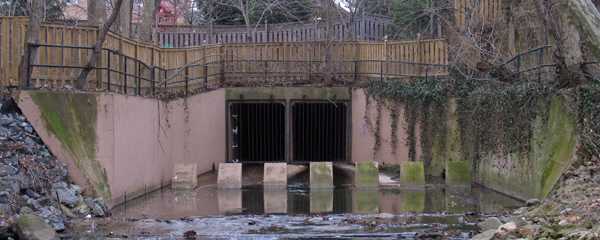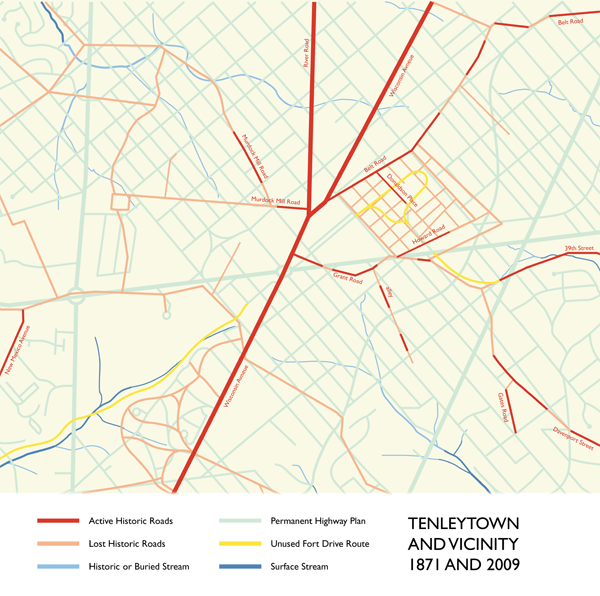 I noticed yesterday that DC has re-signed Murdock Mill Road, down off River Road in Tenleytown. It’s a nice little reminder of history – and of natural geography – among the rationalist streets of the city plan laid down in 1897. While those straight, predictable lines make navigating the city easy, they did erase the context and history of what was Washington County. By its perseverance, this little snippet of prior use reminds residents of the pre-urban past, adding quiet character to the neighborhood.
I noticed yesterday that DC has re-signed Murdock Mill Road, down off River Road in Tenleytown. It’s a nice little reminder of history – and of natural geography – among the rationalist streets of the city plan laid down in 1897. While those straight, predictable lines make navigating the city easy, they did erase the context and history of what was Washington County. By its perseverance, this little snippet of prior use reminds residents of the pre-urban past, adding quiet character to the neighborhood.
The road itself is no larger than an alley – its form preexists both the automobile age and the dreams of a residential garden city, so there are neither sidewalks nor setbacks. It is discontinuous, with one part behind the old Sears Building and the other appearing a few blocks to the west before becoming Butterworth Street. It’s also completely secondary: Where the narrow eastern section intersects with 42nd Street, the heavy grading on the latter route necessitates a concrete retaining wall and a stairway down from Murdock Mill Road, ten feet above. It is very dislocated; left inexplicably during the changes of urbanization, along with the Methodist Cemetery, its only active address.
The road once headed down in the direction of Massachusetts Avenue, following a creek of the same name. Before the imposition of the 1897 Permanent Highway Plan, Murdock Mill Creek began at the west of Tenleytown, and cut through a subdivision of small farms registered as part of Friendship, and finally into what is now the Dalecarlia reservoir. Now, the stream is undergrounded, emerging only from underneath 52nd Place in northern Spring Valley. Other streams have been buried; still more roads have disappeared when developers carved up the farms they existed to serve. Murdock Mill Road is only one of these many streets, some of which are still used.
The two largest paths are Wisconsin Avenue and River Road, both of which were already major commercial routes by the 1810s. However, the Georgetown-Frederick Pike was originally situated slightly to the east, on what is now known as Belt Road, replaced with a straighter route. And there are many others, like Grant Road, Loughborough Road, Gates Road, Howard Road, Chappell Road, and Highland Place. Most of these muddy farmland trails only survive in parts, where no better route could be devised or the road simply could not be demapped. Where routes seemed especially important, new boulevards worthy of the Nation’s Capital replaced uneven donkey trails. The construction of Nebraska Avenue in the 1930s, for example, superceded most of Grant and Loughborough Roads. The grid wiped out most others as neighborhoods were formed.
The remaining fragments are scattered everywhere around the area in unexpected shapes, such as two alleys between Brandywine and and Albermarle streets in Tobago, Belt Road’s many sections, or, of course, Murdock Mill Road. The entire street grid of Reno City is lost except for two small sections, Donaldson Place and an off-axis section of Chesapeake Street. Where all thoroughfares have been lost, more hidden elements, such as oddly defined property lines and strangely oriented houses still bear witness to early origins. These clues to past use lace urban neighborhoods with the trace of tobacco harvest. The conditions that caused these exact roads are not reproducible by means other than the times and places in which they were created and sustained.
They are maps of human activity, embedded into the functioning and living urbanism, even as the physical evidence of the old uses has been erased. They are a sort of museum that is open at every hour and accessible to every person. Not speaking in detail and unobtrusive, they offer a starting point for the curious and at least a curio for the less interested. One might consider the organic road network to be what Peter Eisenman calls a “record of design process.” It is an organization of space that reflects the way it was made; its meaning is only that the result was what had to result from the conditions, so tells viewers of the story of creation and fossilization. It is very distinctly abstract, open to adjustment at finer layers of architectural form.

Saving and reusing these routes is not preservation, it’s contextualization, making place at a very basic level. Unlike a historic building, it offers no obvious examples of taste or lifestyle, rather, the strategy offers a pattern of use that, through its abstraction, is as relevant as it was in 1889. A natural road does not associate with any time in particular, the way a Victorian house or an International Style bank does, it exclusively associates with place, and quite closely so.
The Grid: A Place of Infinite Possiblity
Market streets have their flaws. Old cities often seem cramped and incoherent, inefficient for modern city needs and difficult to navigate. Have you ever been to Boston? Architecturally, without an ordering, areas become isolated and parochial, Tyson’s Corner as much as Shahjahanbad. Made-up irrational plans favored by arch-traditionalist planners such as the Krier brothers often repeat these issues senselessly. These cities are all too often consciously obfuscating and delirious, reliant on aesthetic controls on private property to ensure a sense of relational place. It’s just as limiting as Le Corbusier’s fascist plans for Algiers.
Indeed, the grid has been a manifest sign of liberalism and reason since before the Enlightenment, with precedents in the planning of cities for centuries in almost every culture. But in America, it became central to the design of almost every city built before highways. It reflects an egalitarian and functional plotting system that does not assert a political hierarchy onto the landscape. Instead, it emphasizes humble civic order and equality in government. Furthering its republican design, it is an economical and plain method of organization that still creates distinct locations at intersections. At corners, the fundamental space of a healthy city, one can easily relate one location to many other places, both by sight and by name. The straightforward naming systems possible for a grid plan are really a lifesaver for the perpetually lost.
What makes that freedom is the uniformity of every space. Orthogonal intersections essentially indistinct. But countless cities and towns have developed economically and architecturally with grids. Their success is further proof against architectural determinism, but also a credit to the inventiveness of designers. Where they were unable to build on unusual lots, architects and developers have designed more distinctive buildings, with unusual features or interesting massing, to compensate for the banality of the location. Still, there are limits to compensation. Looking at Los Angeles from space, the early endless expanse of the grid does indeed look boring. Walking these streets, even on a thoroughfare like La Cienega, is an agonizingly monotonous experience no one should ever have to endure – and no one really does at speeds lower than 25 MPH.

The Both-And Boogie
So, the traditional system is too complicated, the grid too simple. A synthesis, or at least a juxtaposition of more than one system creates the most profound city plans. Consider the powerful symbolism of the avenues in DC or the effect of Broadway on New York City. At both cases, the roads that are different than the grids stand out at intersections and suggest new connections to areas not obvious in the neighborhood grids.
Broadway adds many more intersections to the neighborhoods it passes through, connecting each one of those to many other roads that just another avenue never would have. Following the diagonal path across midtown is an easier prospect than navigating the many turns required, with many decisions and judgements. On a single path, no matter how wavy, one can simply relax and walk, as much as on the straight routes of the avenue. In addition to connections, the architects are forced to confront the different relationships these streets have to each other than orthogonal ones do. Such locations really feel and look different – they are formally different enough to suggest a particular meaning.
Their difference, their contradiction is the key. At intersections of two systems of organized space, the experience of each system independently is heightened, while the interplay of the two adds tremendous potential complexity to the architecture and aesthetics of new spaces. New parks and new signature locations are made because their forms are distinct at the most basic level of urban design: the map. Whatever architecture goes up on a site is sure to be different and recognizable, if only because a new, immediate vista is guaranteed.
After walking through a grid to a deviant juncture, a pedestrian notices, “This is different.” The procession of perpendicular streets suddenly is broken and expected geometry is gone. One of the human mind’s most basic functions is to recognize patterns and deviations from them, so pedestrians will recall the location with much more clarity than any other indistinct corner. Architects can further enhance hierarchy or difference by adding new degrees of elaboration, such making one street typologically different, such as an avenue or pedestrian street, or perhaps even an entity like the Emerald Necklace in Boston.
For an architect, unusual sites offer opportunities to innovate by responding to interesting conditions produced by the overlay of the primary grid with the second street system. Similarly, small urban parks can be formed out of undesirable and marginal land, often being just the right size for a small urban park. Although this does not automatically justify the creation of a park, the perceptual difference created by the contrasts of two street plans emphasizes the void, flaunting it to the public, imbuing it with meaning and place as a node or locality in the urban fabric.
To return to Tenleytown now, the situations and intersections in the area bear out the lessons of abstract theories of place. In fact, planners have employed a system of overlaid information in the design of the grid plan. Olmsted & Co. used employed two kinds of differences: obviously the avenues and circles but also a handful of parkways and roads that curve gracefully among the numbered and named streets.
In the case of the avenues, the monumental size and width of the streets connects distant circles and squares. The broad avenues cut up the city into aggressive triangular shapes, disrupting and contrasting with the alphanumeric grid. From a side street, they appear special due to the contradiction of the street’s pattern. Conversely their size and directness make the side streets fade into the urban fabric, only emerging at the circles and squares that further punctate the experience of space. Since these circles often act as excellent community centers, loci of neighborhoods, the architectural meaning of the avenue dovetails nicely with the social meaning of each location. But avenues can really only represent certain universal concepts, an elegant geometry, governed with strict rules. Content added in ornamentation, such Gutzon Borglum’s masterful statue of General Sheridan, is usually awe-inspiring, but it’s still universal and absolute, just like the grid. It deals neither with the time nor the real place; it can only ever seem artificially timeless, still trapped within it by human memory.
However, in the second case, Olmsted & Co. added a component that inserts the very specific landscape into the streets. Far from being simply picturesque roads designed for amusement, they are completely logical responses to the topography. This logic might not make the most navigable street network by itself, but again, with a grid that casually ignores the land it is laid upon, these natural roads suddenly make pedestrians passing through the area aware of the hills: not only changes in elevation, but also the shape of the hills and valleys, hiding and disclosing its path and unfolding the geometry as one passes through it. Again, the experience of this is enhanced by the other streets, where the rigid grid contrasts with the almost mysterious curve. Where Reno Road approaches streets at a small angle, it generates strong geometries that also avoid the pompousness of the avenues.
How did I get here?
But the curves are still selective and romantically landscaped. Olmsted eliminated much of the natural geography to make flatter lots and better curves. Although the planners replaced the unique roads and textures with similar ones of local meaning, they offer no connection to time, no key to history. The few leftover segments are known to most residents, who have some understanding that they are older than the city’s form. Yet without significant interrelation, the disconnected sections only produce interesting geometries, not creating a narrative, so to speak. Fragmentation is a fascinating aesthetic experience but it loses much of its value as a placemaking strategy by eliminating the connections that are so vital to cities. Disconnected streets are a wonderful puzzle, left for long, metaphysical explanations on the internet, but they don’t add too much history to the daily lives of people.
It would be nice if Belt Road did connect Wisconsin Avenue to Brookville Road, a useful route in addition, if nothing else. But we can also enjoy the pattern as a puzzle, the scant evidence a fun project of unravelling the layers that have formed over the land. One delves into the past more and more as they find each little bit, becoming more and more party to the open secrets of the city.
I decided to visit the first daylight of Murdock Mill Creek on a cloudy Sunday. Finding it was a surreal journey of one half mile from where it passes under Dalecarlia Parkway to the mouth of the tunnel. For most of that distance, the stream looks no different than Broad Branch, undisturbed even as it is surrounded by shear highway retaining walls supporting the backyards of McMansions. It’s just a small creek, down at the bottom of a valley, and only when one gets to the concrete spillway does anything seem unnatural. The water flows out of a concrete box ten feet high, bluntly stuck under someone’s lawn. Its generous opening seems a little funny compared to the modest flow itself; engineers obviously wanted to be sure the stream never reemerged in someone’s basement.
Staring through the iron grill that keeps the illegally curious out, it becomes impossible to not wonder where hidden path goes. If I understood where it went, then I would understand where I am.

If you want to learn more, the Tenleytown Historical Society has excellent resources.

Another street sign, now gone, that hints at DC’s history was the street sign for Rives Station Road at the DC boundary with PG County on Bladensburg Road. The road itself is about 30 feet long between the railroad and Bladensburg Road. There are no buildings on it. There is no sign of the old train station (if it was anything more than a platform) or the old Rives farm.